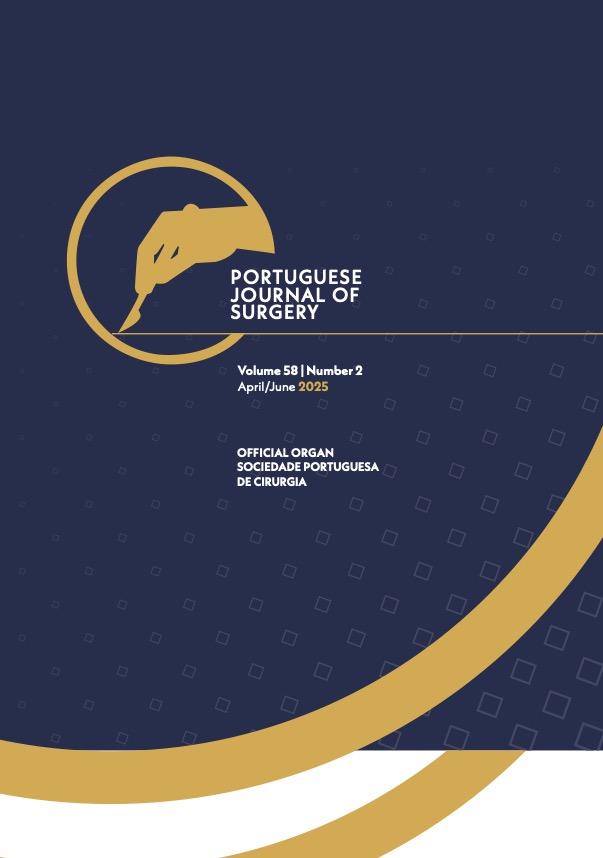Malignant Potential of Gallbladder Polyps: Do they all have Surgical Indication?
DOI:
https://doi.org/10.34635/rpc.995Keywords:
Cholecystectomy, Laparoscopic, Gallbladder Neoplasms/diagnosis, Gallbladder Neoplasms/surgery, Polyps/diagnosis, Polyps/surgeryAbstract
Introduction: Gallbladder polyps (PV) are mucosal lesions that protrude into the lumen of the gallbladder. Most patients are diagnosed incidentally because they are asymptomatic. The presence of PV is a known risk factor for gallbladder cancer. According to the guidelines, cholecystectomy is recommended, which leads to unnecessary resection in one-third of patients, as the PV subsequently proves to be benign. This study evaluates the malignant potential of vesicular polyps to determine whether they are all indications for laparoscopic cholecystectomy.
Methods: Retrospective observational study of 151 patients with an ultrasound diagnosis of vesicular polyps who underwent cholecystectomy performed at our centre from 2018 to 2022 inclusive. The prevalence of gallbladder polyps and gallbladder cancer in this population was assessed and predictive factors for malignancy were characterized using statistical analysis in SPSS (Statistical Package for Social Sciences) version 27.
Results: A total of 151 patients with an ultrasound diagnosis of vesicular polyps who had undergone cholecystectomy over five years were evaluated. Participants were divided into 84 (55.6%) asymptomatic and 67 (44.4%) symptomatic. Pathological anatomy confirmed the presence of PV in 96 (63.6%) surgical specimens and its absence in 55 (36.4%). Five (3.3%) cases of gallbladder cancer (GBC) were detected in the total. Among the cases with GBC, all participants were 60 or older; one (20%) was female and 4 (80%) were male. All patients had a history of gastrointestinal tract neoplasms and all cancer-related PVs measured between 6 and 9 mm in the longest axis.
Conclusion: Patients aged 60 years or older, with a PV with a larger axis dimension between 6 and 9 mm and with a history of gastrointestinal tract neoplasms have a higher risk of developing true bladder polyps and consequently a higher likelihood of GBC.
Downloads
References
2. Aziz, H., D.B. Hewitt, and T.M. Pawlik, Critical Analysis of the Updated Guidelines for Management of Gallbladder Polyps. Ann Surg Oncol, 2022. 29(6): p. 3363-3365.
3. Candia, R., et al., Follow-up of gallbladder polyps in a high-risk population of gallbladder cancer: a cohort study and multivariate survival competing risk analysis. HPB (Oxford), 2022. 24(7): p. 1019-1025.
4. Zhang, X., et al., A nomogram-based model and ultrasonic radiomic features for gallbladder polyp classification. J Gastroenterol Hepatol, 2022. 37(7): p. 1380-1388.
5. Liu, J., et al., Value of prediction model in distinguishing gallbladder adenoma from cholesterol polyp. J Gastroenterol Hepatol, 2022. 37(10): p. 1893-1900.
6. Wang, X., et al., Conventional Ultrasound Combined With Contrast-Enhanced Ultrasound in Differential Diagnosis of Gallbladder Cholesterol and Adenomatous Polyps (1-2 cm). J Ultrasound Med, 2022. 41(3): p. 617-626.
7. Sasaki, T., et al., Gallbladder Intramucosal Carcinoma Arising in a Cholesterol Polyp: A Case Report. Cureus, 2022. 14(3): p. e22898.
8. Kamaya, A., et al., Management of Incidentally Detected Gallbladder Polyps: Society of Radiologists in Ultrasound Consensus Conference Recommendations. Radiology, 2022. 305(2): p. 277-289.
9. Halaseh, S.A., S. Halaseh, and R. Shakman, A Review of the Etiology and Epidemiology of Gallbladder Cancer: What You Need to Know. Cureus, 2022. 14(8): p. e28260.
10. Chan, B.K.Y., et al., Surgical management of suspected gallbladder cancer: The role of intraoperative frozen section for diagnostic confirmation. J Surg Oncol, 2022. 125(3): p. 399-404.
11. Riddell, Z.C., et al., Gallbladder polyps and adenomyomatosis. Br J Radiol, 2022: p. 20220115.
12. Matsumori, T., et al., Mapping biopsy for bile duct cancer using a novel device delivery system. Endoscopy, 2022. 54(5): p. E217-E219.
13. Tamura, T., R. Ashida, and M. Kitano, The usefulness of endoscopic ultrasound in the diagnosis of gallbladder lesions. Front Med (Lausanne), 2022. 9: p. 957557.
14. Foley, K.G., et al., Management and follow-up of gallbladder polyps: updated joint guidelines between the ESGAR, EAES, EFISDS and ESGE. Eur Radiol, 2022. 32(5): p. 3358-3368.
15. Zhang, D., et al., Establishment of a nomogram prediction model for long diameter 10-15 mm gallbladder polyps with malignant tendency. Surgery, 2021. 170(3): p. 664-672.
16. Alyanak, A. and F. Aslan, Gallbladder Polyp and Cancer Evaluation After Cholecystectomy: A Retrospective Observational Study. Cureus, 2022. 14(8): p. e28089.
17. Foley, K.G., et al., Risk of developing gallbladder cancer in patients with gallbladder polyps detected on transabdominal ultrasound: a systematic review and meta-analysis. Br J Radiol, 2022. 95(1137): p. 20220152.
18. Dilek ON, K.S., et al. , Diagnosis and Treatment of Gallbladder Polyps: Current Perspectives. Euroasian J Hepatogastroenterol 2019. 9: p. 40-48.
19. Feo, C.F., et al., Current management of incidental gallbladder cancer: A review. Int J Surg, 2022. 98: p. 106234.
20. Vega, E.A., et al., Treatment of Resectable Gallbladder Cancer. Cancers (Basel), 2022. 14(6).
21. Walsh, A.J., D.B. Bingham, and A. Kamaya, Longitudinal Ultrasound Assessment of Changes in Size and Number of Incidentally Detected Gallbladder Polyps. AJR Am J Roentgenol, 2022. 218(3): p. 472-483.
22. Newton, A.D., et al., Robotic Completion Radical Cholecystectomy with Fluorescence Guidance. Ann Surg Oncol, 2021. 28(11): p. 6834.
23. Abdelal, H. and D. Chatterjee, The Clinical and Pathologic Features of Intracholecystic Papillary-Tubular Neoplasms of the Gallbladder. Surg Pathol Clin, 2022. 15(3): p. 565-577.
Downloads
Published
Issue
Section
License
Copyright (c) 2022 Portuguese Journal of Surgery

This work is licensed under a Creative Commons Attribution-NonCommercial-NoDerivatives 4.0 International License.
Para permitir ao editor a disseminação do trabalho do(s) autor(es) na sua máxima extensão, o(s) autor(es) deverá(ão) assinar uma Declaração de Cedência dos Direitos de Propriedade (Copyright). O acordo de transferência, (Transfer Agreement), transfere a propriedade do artigo do(s) autor(es) para a Sociedade Portuguesa de Cirurgia.
Se o artigo contiver extractos (incluindo ilustrações) de, ou for baseado no todo ou em parte em outros trabalhos com copyright (incluindo, para evitar dúvidas, material de fontes online ou de intranet), o(s) autor(es) tem(êm) de obter, dos proprietários dos respectivos copyrights, autorização escrita para reprodução desses extractos do(s) artigo(s) em todos os territórios e edições e em todos os meios de expressão e línguas. Todas os formulários de autorização devem ser fornecidos aos editores quando da entrega do artigo.



